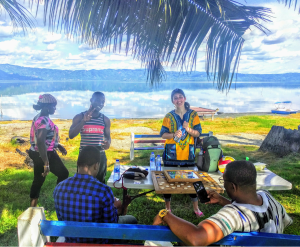by Danielle Tsougarakis, Bioengineering ’20; Jason Grosz, Bioengineering ’19; Ethan Zhao, Bioengineering ’19; and Kate Panzer, Bioengineering ’18

David Issadore, a faculty member in the Department of Bioengineering at the University of Pennsylvania teaches an engineering course ENGR566 – Appropriate Point of Care Diagnostics. As part of this course, he and Miriam Wattenberger from CBE, have taken nine Penn students, most of them majoring in Bioengineering, to Kumasi, Ghana, to study the diagnosis of pediatric tuberculosis. While in Ghana, these students are blogging daily on their experiences.
This morning, we headed to Lake Bosomtwe, which is in the Kumasi metropolitan area. The setting was surreal, with an expansive lake surrounded by rich vegetation and puffy white clouds. Lake Bosomtwe is the only natural lake in Ghana, formed by a collision with a meteor millions of years ago. However, the local story behind the lake’s origin involves a hunter who seeks to shoot an antelope. The first day, he goes into the forest and successfully shoots an antelope, but the animal runs away. The next day, the hunter once again goes into the forest and successfully shoots the antelope, but the same escape occurs. Finally, on the third day, the hunter decides to follow the antelope after it has been shot. The hunter ends up at a small pond and sees the antelope enter the water and disappear. The hunter determines that the antelope is a ghost and decides to name the pond “Antelope god,” or Bosomtwe in Twi, one of the languages of Ghana. Bosom translates to “god,” and twe means “antelope.”

Now there are 22 communities surrounding the perimeter. We found out it would take eight hours to walk around the entire lake – a trek no one wanted to attempt. However, we did get to wade into the warm water and explore further with the paddleboats. At first glance, the water appeared polluted with scattered plastic bottles. Upon further examination, we realized these were actually makeshift flotation devices for fish traps. We later saw a group of young boys wading through the water catching fish with their hands. Overall, there weren’t a lot of other people there, and we were the main tourist group.
After dinner, we converted our dollars to Ghanian cedis by a currency exchanger named Aness. Aness was a Muslim born in Kumasi with heritage in Niger, and we had an extensive discussion about the various aspects of his identity, including his identifications with Kumasi, Ghana, and Islam. First, even though his parents came from Niger, he identified more strongly with Kumasi and Ghana since he was born here, saying, “You must be proud of where you are born because it’s the only thing you have.” He was extremely proud of the fact that Kumasi was the cultural center of Ghana. He seemed to have very strong stereotypes against people from Accra, claiming that the businessmen were dishonest and cared only about making money, not the way it was made. He also explained to us the use of various regional dialects across Ghana. In Kumasi, the primary language of communication is Twi.

